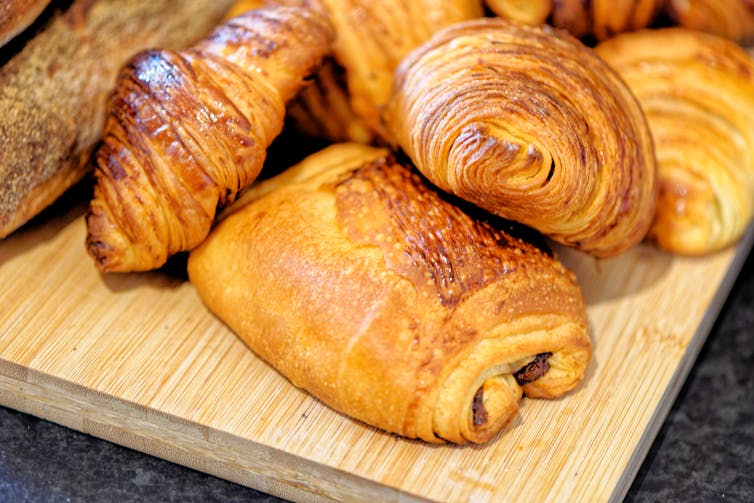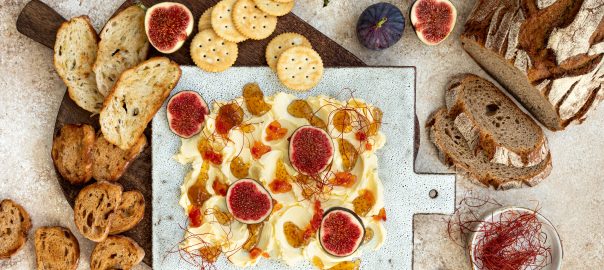Duane Mellor, Aston University
In an unexpected twist, butter seems to be back on the menu. After years of being a maligned ingredient that many people shied away from, butter has now become the latest food trend on social media, thanks to the recent popularity of “butter boards”.
These are sort of the meat-free equivalent of a charcuterie board. Butter is whipped then spread onto a chopping board, sprinkled with a variety of toppings – from sweet to savoury – and served with an accompaniment of choice (such as bread or a toasted baguette).
But although they may be delicious, butter is still full of saturated fat – which many of us know can be harmful to our health. Here’s what you may want to consider before whipping up a butter board of your own.
Is butter really that bad?
Butter is made from cream, the fat-rich part of milk. While it’s usually made from cow’s milk, it can also be made from other milks such as goat milk.
The reason that butter has been seen as a no-go for so many years is because it’s one of the ultimate sources of saturated fat. Butter contains around 80% fat, of which about two-thirds is saturated fat. It contains little else nutrient-wise.
Saturated fats should be avoided in large amounts as they’re linked with many health problems, including heart disease and shorter life expectancy. Clinical trials have also shown that saturated fats can have an negative effects on blood cholesterol levels.
When it comes to butter on its own, it appears that eating it has a relatively small or neutral effect on the risk of heart disease. But research that compared butter to olive oil (another source of saturated fat) found that butter can increase levels of LDL cholesterol, which is sometimes called “bad” cholesterol as it’s linked to greater risk of heart disease.
But the majority of the butter many of us consume in our diets comes from other foods such as biscuits, cakes and pastries. Alongside butter, these foods tend also to contain high amounts of sugar, while being low in other nutrients. High intakes of these types of foods is also linked with greater risk of heart disease.

Ion Mes/ Shutterstock
Overall, sharing a butter board with friends every now and then is unlikely to cause much harm to your health. But doing it often, or eating very large quantities, could raise cholesterol levels and increase your risk of cardiovascular disease somewhat.
It’s also worth bearing in mind what toppings you serve your butter board with. Certain foods (such as processed or cured meats) also contain saturated fats, and should only be enjoyed occasionally.
Butter alternatives
Since butter is very calorific and fat-rich, some people may want to look at using butter alternatives for the base of their butter board.
The first substitute many people might look to is margarine. Margarine is chemically very similar to butter. Depending on the product though, it only contains around 40%-70% fat, making it a lighter alternative with a possibly similar taste.
In the past, the processes needed to make margarine solid resulted in the production of trans fats, which have been linked to increased risk of heart disease. But these processes have since been improved so margarine no longer contain trans fat. So it may be a good option for people wary of the amount of fat they consume.
Another alternative people may look at using is ghee, also sometimes known as clarified butter. A staple of Indian cooking, this is still made from milk, but the fat is much more concentrated as most of the water has been simmered away. This means it won’t have the same creamy texture as butter.
Grass-fed ghee is as rich in saturated fats as butter. It also contains naturally produced trans fats. However, these trans fats are different to the industrially produced types which are bad for our health. But since ghee contains more calories than butter, it may not be the best choice for a butter board, especially if you’re looking for the best flavour.
Cultured butter may also be a choice for your butter board. This is made from cream which has been fermented like yoghurt. However, no research to date has looked at whether the probiotics in cultured butter provide the same health benefits as those in yoghurt and other fermented foods. Nutrition-wise, it contains the same amount of fat and calories as regular butter.
All in all, butter is not bad. But since it’s very high in calories and cholesterol, you may want to try not to have too much. Sharing a butter board with some friends or loved ones every now and again is unlikely to have any long-term negative impact on your health.
Duane Mellor, Lead for Evidence-Based Medicine and Nutrition, Aston Medical School, Aston University
This article is republished from The Conversation under a Creative Commons license. Read the original article.

